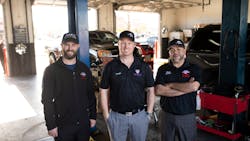Something that every shop owner can agree on is that they want customers to return to their shop. While the customer base may vary by shop, fleet customers can bring an opportunity of repetition that differs from the average retail customer. Maintaining these accounts can be a different experience to navigate as well.
NOLN spoke with three quick lube operations about their fleet approach. There are many details to keep in mind when it comes to forming an effective strategy, and these operations share some insight into how they build relationships with and provide for fleet customers.
Meet the Experts:Howard Koffman, business development manager for fleets at Stonebriar Auto Services:
|
Build a Relationship
Howard Koffman’s career experience working with fleets has aided him in establishing an approach for Stonebriar. He says his work at Shell revolved around the desire to get new business and cultivate long-lasting relationships. He brought this same outlook into his work with Stonebriar.
“They knew with the right person and the right actions at store level, fleets could be at the vital pillar of growth for Stonebriar,” Koffman says. “So, with that culture ... a lot of store training, and the folks who I knew in the industry, I put together a program to help train the stores on fleet awareness.”
According to Koffman, successful fleet service comes down to the quality of the customer relationship built.
“I was brought in here to acquire and maintain customers, and I think over my career it’s always developing the new business, developing that relationship and watching that build,” Koffman says. “Because once you develop a relationship, they’re going to come back to you. If they have a problem, they’re going to call you.”
He says the types of fleet accounts and the frequency of fleet customers can differ depending on where a shop is located.
“The strategies may vary based upon geographics, and with Stonebriar … things that work very well in Arkansas have to be slightly different up in Ohio and Georgia,” Koffman says.
Koffman says larger national fleets may have more vehicles and a bigger territory. This means they could potentially come across a store and decide to use it for service, but he says national fleets also tend to have more options for approved vendors.
Koffman says local fleets tend to hold onto their vehicles for longer periods of time than national fleets, which provides more service opportunities. He says local fleet owners are usually dealt with on a more one-on-one basis, which means a deeper customer relationship can be formed.
“It’s that local person who will buy more, once you build that trust,” Koffman says.
Koffman recommends shops that are interested in servicing fleets more look at their ability to bring on or incorporate a dedicated fleet employee. They could be part-time or even full-time depending on the size and scale of the operation.
Regardless of if that position is a possibility or not, he says keeping staff aware of the ins and outs of fleet service will help strengthen a shop’s fleet reputation.
“If you don’t know how to service a fleet, you alienate that customer, he will not … want to come back and tell his or her friends, ‘Hey, they didn’t even know how look up a fleet account’ or, ‘They didn’t look at the rules enough,’” Koffman says.
This educational piece is critical. Koffman says the frequency in which fleets are serviced is higher than the average retail customer. He says shops could see fleets come in multiple times per year versus the one or two times you may see a retail customer. Additionally, Koffman says developing a fleet program to its full potential may require some patience.
“Fleets take a good three to six months to nurture because not everybody gets an oil change or service every week,” Koffman says. “So, to really look at the success of a program they need to give it a good six-month investment and see how many accounts were open, what the profitability was, did they come back, and how many new customers?”
A Welcome Approach
For Jordan Mosley, building rapport with fleet customers starts by crafting a welcoming atmosphere in the shop. He says many fleet customers come in first thing in the morning, and it’s nice to leave a good impression on their day.
“So having fresh coffee, having things of that nature, having a clean facility, getting them in and out in a timely manner is super important,” Mosley says.
He says once you foster that relationship, fleet customers are more likely to return because they know they can count on reliable service and quality experience. But like Koffman, Mosley points to location as something to consider for fleet customer availability.
“We have some locations that only do like a few hundred dollars a month in national and local fleets and then we have others that do tens of thousands of dollars every month in national and local fleets,” Mosley says. “It just depends on the location honestly and what’s around it.”
The type of fleet comes into play as well. Mosley says his locations conduct more consistent business on the national fleet side.
“Once you get in pretty good with the national fleets and you’re starting to service them and they can trust you, they’ll actually refer other fleet companies to your store because they do rate you on the back end,” Mosley says.
Mosley says one challenge to working with local fleets is that they may not use your services as much as they initially claim they will, and price negotiations can be another factor. Mosley recommends working with a local fleet for a little while to ensure that they are utilizing your services enough before you offer any discounts.
However, Mosley has been able to form some great friendships through the cultivation of local fleet accounts. He says the local approach can form organically.
“If a local fleet does come in, just (strike) up a conversation with them,” Mosley says. “(Ask) how many vehicles they have in their fleet, how often they’re changing the oil … just getting that information for the decision maker and then passing it along to the manager or the district manager or owner to follow up and give them a call to see if they want to set up something.”
Once you have regular fleet accounts coming in, Mosley says you’ll get to know the services they routinely get done. He says this knowledge can provide an opportunity.
“So most fleets you'll know exactly what they want once you set everything up, you'll know, hey, they do oil change, air filter, and wiper blades … that’s it, they're easier to upsell on fleets, versus I would say the average customer,” Mosley says.
Mosley says fleets require some legwork upfront. He suggests ensuring that time is spent training team members on the different processes required. Mosley says he used to have a dedicated fleet employee, but for the size of his operation it didn’t make sense to keep this position. For outreach purposes, he recommends owners put in the effort to reach out to potential customers.
“The relationship with the fleet company is built by the store manager and its crew,” Mosley says. “You just have to nurture and cultivate each time the driver comes into the business to store for an oil change or service because they're the ones that are going to be coming back.”
Large-Scale Strategy
Given the sizable network of Valvoline Instant Oil Change locations, the Valvoline approach requires consistency. According to Snyder, with fleets this includes aiming to get them taken care of within 15 to 20 minutes.
“A big selling pitch for us when we go in is what is an hour of your time in that vehicle worth?” Snyder says. “And a lot of them know it immediately … so, from there we can say, using our method and VIOC then you can add this much profitability to your business by time saved.”
Wade explains that Valvoline’s proprietary POS system helps manage the fleet approach down to the store level, making it easier to keep track of various clients and their needs.
He says the ability to follow prompts through this system allows the technician to concentrate on a quality service instead of procedural steps. Fleets are part of the overall Valvoline training process as well, because the details are important with fleet interactions.
“The decision maker is not behind the wheel,” Wade says.
But maintaining these fleet relationships involves understanding what the customer wants and what they don’t, Wade says.
“I would describe it as you’ve got to thread the needle, because fleet managers care about two things almost equally: the safety and reliability of their vehicle,” Wade says. “But not spending on things that are unnecessary on that vehicle.”
According to Snyder, another consideration is the practice of developing a relationship that drives repeat business versus what’s expected of the average retail customer. He says with fleets you may only see 5% of their 100 vehicles, but it’s Valvoline’s goal to also strive for that other 95%.
“We’re looking for deeper penetration into these fleets, whereas consumers you’re only dealing with a small number of vehicles per family,” Snyder says.
Snyder says distinguishing the fleet from the consumer is an important aspect of service, especially because Wade foresees that more fleet vehicles are on the horizon. Wade says compared to 10 years ago, there are many more on the road due to the influence of companies like Amazon and rideshare options.
“The fleet world is changing,” Snyder says. “There are businesses that use fleet to do business and then there’s businesses that their fleet is the business.”
Despite any changes, Wade says that one thing will remain consistent: The Valvoline commitment.
“Our overall tenet is to be quick, easy and trusted,” Wade says. “So that’s the message we give to the fleet managers as well. We try to take their business model and set everything up for that.”
About the Author
Hanna Bubser
Editor
Hanna Bubser is the editor of National Oil and Lube News and has been writing about the automotive aftermarket since 2022. She has a bachelor's degree in English from Hamline University in St. Paul, Minnesota. As a teenager, she drove a green 1996 Jeep Cherokee that was previously used as a forest service vehicle. Currently, she drives a 2019 Subaru Impreza. She's an avid bumper sticker collector and loves adorning her vehicle with brightly-colored conversation starters.

